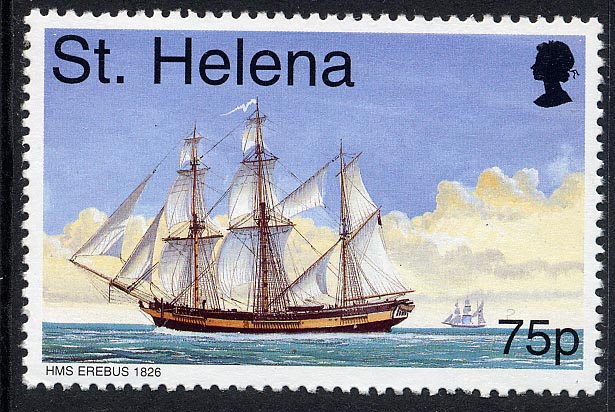Built as a Hecla class bomb vessel by the Pembroke Dockyard, Pembroke for the Royal Navy.
09 January 1823 ordered.
October 1824 keel laid down.
07 July 1826 launched as the HMS EREBUS, named after the dark region in Hades of Greek mythology called Erebus.
Tonnage 372 ton (bm), dim. 105.1 x 28.6 x 13.10ft, length of keel 86.1ft.
Armament: 2 – 6 pdr., 8/10 – 24 pdr carronades. Mortars 1- 13 inch and 1 – 10 inch.
Crew 67.
February 1828 completed in Plymouth under command of George Haye.
July 1828 sailed for the Mediterranean
1829 Under command of Philip Broke.
July 1830 paid off.
1839 Fitted out as an exploration vessel for Antarctic service.
April 1839 under command of James Clark Ross.
Together with the HMS TERROR she sailed from the U.K. bound for the Antarctic.
21 November 1840 she departed from Tasmania for Antarctica in company with TERROR . In January 1841, the crew of both ships landed on Victoria Land, and proceeded to name areas of the landscape after British politicians, scientists, and acquaintances. Mount Erebus, on Ross Island, was named for the ship itself.
They then discovered the Ross Ice Shelf, which they were unable to penetrate, and followed it eastward until the lateness of the season compelled them to return to Tasmania. The following season, 1842, Ross continued to survey the "Great Ice Barrier", as it was called, continuing to follow it eastward. The two ships returned to the Falkland Islands before returning to the Antarctic in the 1842-1843 season. The ships conducted studies in magnetism, and returned with oceanographic data and collections of botanical and ornithological specimens. Birds collected on the first expedition were described and illustrated by George Robert Gray and Richard Bowdler Sharpe in The Zoology of the Voyage of HMS Erebus & HMS Terror. Birds of New Zealand., 1875. The revised edition
For their next voyage, to the Arctic under Sir John Franklin, EREBUS and TERROR were outfitted with steam engines (converted from railway locomotive engines), and had iron plating added to their hulls. Sir John Franklin sailed in EREBUS, in overall command of the expedition, and TERROR was again under the command of Francis Crozier. The expedition was ordered to gather magnetic data in the Canadian Arctic and to complete a crossing of the Northwest Passage, which had already been charted from both the east and west but had never been entirely navigated.
The ships were last seen entering Baffin Bay in August 1845. The disappearance of the Franklin expedition set off a massive search effort in the Arctic. The broad circumstances of the expedition's fate were first revealed when Hudson's Bay Company doctor John Rae collected artefacts and testimony from local Inuit in 1853. Later expeditions up to 1866 confirmed these reports.
Both ships had become icebound and had been abandoned by their crews, in total about 130 men, all of whom subsequently died from a number of causes, including hypothermia, scurvy, and starvation while trying to trek overland to the south. Subsequent expeditions up until the late 1980s, including autopsies of crew members, also revealed that their shoddily canned rations may have been tainted by both lead and botulism. Oral reports by local Inuit that some of the crew members resorted to cannibalism were at least somewhat supported by forensic evidence of cut marks on the skeletal remains of crew members found on King William Island during the late 20th century.
The remains of the ships have yet to be found, but are listed by Parks Canada as a national historic site.
On 15 August 2008, Parks Canada, an agency of the Government of Canada announced a CDN$75,000 six-week search, deploying the icebreaker CCGS SIR WILFRID LAURIER with the goal of finding the two ships. The search presumably seeks to strengthen Canada's position in sovereignty over large portions of the Arctic.
A British transport ship, the RENOVATION, spotted two ships on a large ice floe off the coast of Newfoundland in April 1851. The identities of the two ships were not confirmed. It has been suggested that these ships may have been the EREBUS and the TERROR, though it is more likely that they were abandoned whaling ships.
The painting shows the EREBUS in the ice, painted by Fracois Etienne Musin , 19th century
British Antarctic Territory 1973 3p sg 49, scott50. 1991 12p sg200, scott184. 1991 12p sg204, scott ?. 1994 35 + 15p sg247, scott?, 1998 30p sg286, scott?.
Falkland Islands 2008 25p sg?, scott? French Southern & Antarctic Territory 1984 2f60 sg189, scott?. Ross Dependency 1957 3d sg1, scottL1. 1968 2c sg5, scott?. 1995 80c sg33, scottL32. St Helena 1986 1p sg488, scott?. 1998 75p sg 774, scott?.
Ascension Island 2011 15p sg?, scott?
Source:
http://en.wikipedia.org/wiki/HMS_Erebus_(1826) http://www.ageofnelson.org/MichaelPhill ... p?ref=0843 The Sail & Steam Navy List by David Lyon & Rif Winfield.

